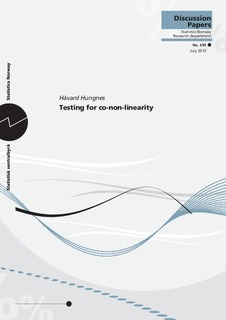Testing for co-non-linearity
| dc.contributor.author | Hungnes, Håvard | |
| dc.coverage.spatial | Norway | nb_NO |
| dc.date.accessioned | 2019-11-13T10:10:17Z | |
| dc.date.available | 2019-11-13T10:10:17Z | |
| dc.date.issued | 2012-07 | |
| dc.identifier.issn | 0809-733X | |
| dc.identifier.uri | http://hdl.handle.net/11250/2628120 | |
| dc.description.abstract | This article introduces the concept of co-non-linearity. Co-non-linearity is an example of a common feature in time series (Engle and Koziciki, 1993, J. Bus. Econ. Statist.) and an extension of the concept of common nonlinear components (Anderson and Vahid, 1998, J. Econometrics). If some time series follow a non-linear process but there exists a linear relationship between the levels of these series that removes the non-linearity, then this relationship is said to be a co-non-linear relationship. In this article I show how to determine the number of such co-non-linear relationships. Furthermore, I show how to formulate hypothesis tests on the co-non-linear relationships in a full maximum likelihood framework. | nb_NO |
| dc.language.iso | eng | nb_NO |
| dc.publisher | Statistisk sentralbyrå | nb_NO |
| dc.relation.ispartofseries | Discussion papers;699 | |
| dc.subject | JEL classification: C32 | nb_NO |
| dc.subject | JEL classification: E43 | nb_NO |
| dc.title | Testing for co-non-linearity | nb_NO |
| dc.type | Working paper | nb_NO |
| dc.description.version | publishedVersion | nb_NO |
| dc.subject.nsi | VDP::Matematikk og Naturvitenskap: 400::Matematikk: 410::Statistikk: 412 | nb_NO |
| dc.source.pagenumber | 25 | nb_NO |
Tilhørende fil(er)
Denne innførselen finnes i følgende samling(er)
-
Discussion Papers [1002]
